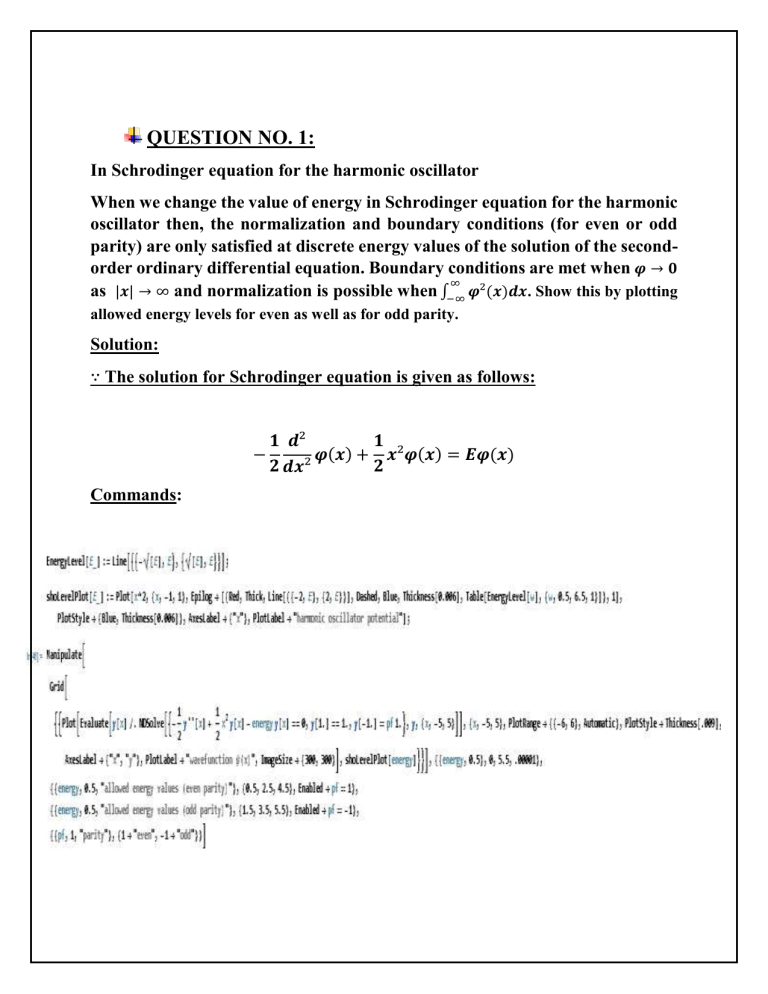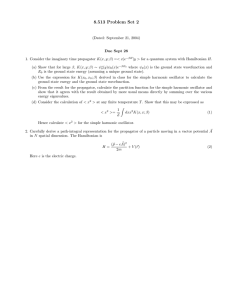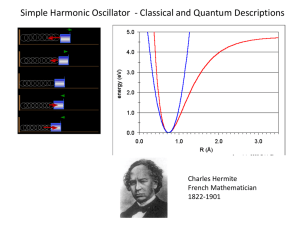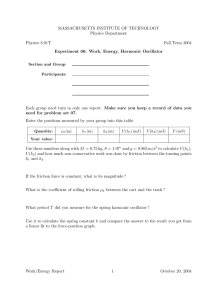
QUESTION NO. 1: In Schrodinger equation for the harmonic oscillator When we change the value of energy in Schrodinger equation for the harmonic oscillator then, the normalization and boundary conditions (for even or odd parity) are only satisfied at discrete energy values of the solution of the secondorder ordinary differential equation. Boundary conditions are met when 𝝋 → 𝟎 ∞ as |𝒙| → ∞ and normalization is possible when ∫−∞ 𝝋²(𝒙)𝒅𝒙. Show this by plotting allowed energy levels for even as well as for odd parity. Solution: ∵ The solution for Schrodinger equation is given as follows: − Commands: 𝟏 𝒅² 𝟏 𝝋(𝒙) + 𝒙²𝝋(𝒙) = 𝑬𝝋(𝒙) 𝟐 𝒅𝒙² 𝟐 ALLOWED ENERGY VALUES (EVEN PARITY) ALLOWED ENERGY VALUES (ODD PARITY) QUESTION NO. 2: If the Schrodinger equation for the harmonic oscillator is: ℏ2 ⅆ 2 𝜓 1 − + 𝑚𝜔2 𝑥 2 𝛹 = 𝐸𝛹 2𝑚 ⅆ𝑥 2 2 (i) Where, 𝜖=√ 𝑚𝜔 𝑥 ℏ (ii) Then, (a) Find the ground state energy of the harmonic oscillator, to five significant digits by the “wag-the-dog method” method. (b) Find first three excited state energies for the harmonic oscillator by the wagthe-dog-method. Solution: Schrodinger equation in terms of 𝜖: Substitute eq (i) into eq (ii): ⅆ2𝜓 = (𝜖 2 − 𝐾)𝛹 ⅆ𝑥 2 (iii) ∵ 𝑘 is the energy, in units of (1/2)ℏ𝜔: 𝑘= 2𝐸 ℏ𝜔 (iv) What is WAG-THE-DOG method: Literal meaning: it refers to something important or powerful being controlled by something less so. Or, it could be used to indicate that attention is purposely being diverted from something of greater importance to something of lesser importance. Wag-the-dog in quantum mechanics: this method is used to find the energy and wavefunction for the first or second eigenstate of a linear or square potential, and then find the best variational approximation to the state using a trial wavefunction based either on a Gaussian or a cosine-squared function. In simple words, wag-thedog method is used to find the energies and wavefunctions of the harmonic oscillator by changing the value of ′𝑘′ until we get a wave function that goes to zero at large 𝜖. Commands: QUESTION NO.3 The unperturbed harmonic oscillator has the Eigen functions where is a Hermite polynomial. The perturbed oscillator has an analogous form, with a shifted argument: For an electron (mass , charge ) bound by a harmonic potential and acted upon by a constant external electric field . Commands: QUESTION NO.4 The classical damped harmonic oscillator is described by the well-known equation where is the mass of the oscillating particle, k is the Hooke’s law force constant and is a damping constant. It is convenient to define the modified damping constant QUESTION NO.5 How the ground-state (n=0) energy V’(x) =σx3 shifts as cubic and quadratic V’(x) = σ/30 x2 perturbations are added to the potential, where σ characterizes the strength of the perturbation. The left graphic shows unperturbed Vharmonic and the perturbed potential Vharmonic + V’ and the right graphic shows E0<0> along with an approximation to the perturbed energy E0 obtained via perturbation theory. For a quadratic perturbation, the lowest-order correction to the energy is first order in σ, so that, E0=E0<0> + E0<1>. For a cubic perturbation, the first-order correction vanishes and the lowest-order correction is second order in σ, so that E0=E0<0> + E0<2>. QUESTION NO.6







